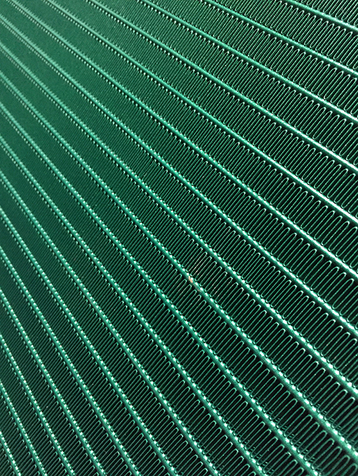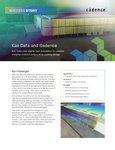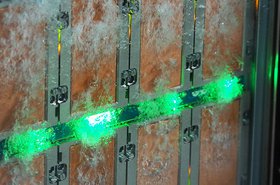Part 1 of this series looked at the causes and consequences of corrosion in data center free cooling system components such as air to water heat exchangers. Now, let us turn our attention to the precautionary measures that can help to minimize the risk of equipment failure.
A free cooling system, including the mechanical back-up cooling, is one of the most mission critical components of a data center, so it is vatal that it is fully maintained and operationally efficient. Although leakage checks, regular filter changes and the thorough cleaning of air-cooled heat exchanger surfaces are common maintenance tasks, in order to ensure reliable operation in the long-term, preventive corrosion protection should be addressed as early as possible after installation.
Damage limitation
Measurable material changes can quickly occur in individual components but an effective corrosion protection strategy can significantly extend the operational life of a free cooling system. The good news is that there are now various options for protecting air-cooled heat exchangers from this threat.
Although thicker aluminum fins protect against premature breakage, during plant operation extra fin width can block airflow, thereby reducing efficiency. A better option is the use of Cu/Cu coil fins, as they eliminate the effects of galvanic corrosion because both the tubes and fins are made entirely of copper. Cu/Cu coil fins are relatively expensive though and offer only a limited advantage compared to aluminum fins. Since they mainly protect against galvanic corrosion, they are mainly considered for installations in the immediate vicinity of the sea.
Coating
In addition to structural measures, modern coating techniques should also be considered. Spray coating provides protection against all types of corrosion and is relatively inexpensive compared to other types of coating. However, a well-known problem when using it is that there can be gaps in the top coat, so while it is recommended for conventional installation conditions, it is less suitable for locations with very high ambient pollution from exhaust gases, acid rain or salty air.
Unlike spray coating, cathodic dip coating offers high layer uniformity. In this process, a heat exchanger is electrically charged and then completely immersed in a chemical bath. The coating adheres uniformly to all surfaces with no gaps and achieves the thinnest protective layer of all coating processes, with little effect on thermal conductivity. The disadvantage here, however, is the significantly higher price for a technically complex process.
So what’s the best option? Under test conditions spray coating with aluminum pigmented polyurethane (Blygold) offers the most effective protection overall, however, the risk of gaps remains. Ultimately, although it has a lower salt spray test value, cathodic dip coating is a more reliable technique. Coating with epoxy resin is behind other processes in terms of performance and corrosion protection effect, but has a significantly lower process cost.
Fluid movement
As discussed previously, the quality of the water in a chilled water circuit is vital for comprehensive corrosion protection. Those who pay attention to water quality right from the initial filling stage not only improve system life, but also benefit from higher plant efficiency. However, water composition can be quite different depending on the application and conditions, and the corrosiveness of a given water mixture differs depending on the material composition in the cooling circuit.
Most chilled water circuits use a range of materials that have different chemical properties including black steel, copper, stainless steel, grey cast iron, aluminum, silver solder and rubber seals. Design based corrosion prevention that standardizes the materials used is an option but is costly and often impossible to implement in practice. The question therefore arises as to how a system can be protected against corrosion. The only sensible, and also the simplest, option for corrosion protection in chilled water systems is the continuous monitoring and adjustment of the water conditions.
pH value
The water’s pH value should be considered. The average pH value of tap water is 7.5 and a too high or too low acidity or basicity figure should be avoided because different materials have different pH ranges in which they can form a protective oxide layer. If this range is undercut or exceeded, the risk of corrosion increases significantly – leading to acid corrosion.
The problem with pH value is that after a system has been filled, a large proportion of dissolved carbonic acid is still contained in the circulating water. This proportion gradually escapes as carbon dioxide and, due to the lack of carbonic acid, the pH value therefore increases and an exact adjustment of a pH value is almost impossible. If there is a mix of materials in the pipe network, the range of values in which the pH value does not have a corrosive effect on any components is reduced.
Under attack
Conductivity is a measure of the ability of water to pass an electrical current. It is determined by the amount of anions and cations dissolved in the water including minerals such as magnesium, calcium and hydrogen carbonate, as well as salts and dissolved metal ions. The more ions present, the higher the conductivity leading to greater susceptibility to electrolytic corrosion. In chilled water systems lime always precipitates at the warmest point with the lowest flow velocity, and in most cases this is a heat exchanger.
To prevent freezing of the piping system, outdoor water circuits are filled with a water-glycol mixture as standard. Glycol, however, can enhance the corrosive properties of the fill water under certain conditions and if oxygen is dissolved in the water, glycol can decompose. This produces acids that acidify the water-glycol mixture and, in individual cases, the manufacturers of glycols must be contacted and their technical data sheets consulted.
It’s worth noting that seemingly simple measures can help to improve protection against corrosion. It is advisable to remove coarse dirt such as leaves, pollen and dust from heat exchanger surfaces at regular intervals and then check the coating for contamination and damage. Finally, when using a cleaning agent, make sure that it is compatible with the coating used – information about this can be provided by the system manufacturer.
Strategic direction
A comprehensive air conditioning system maintenance strategy should include preventive corrosion protection. In addition, data center owners and operators should get to grips with water quality. Although recommendations will vary depending on the situation, the oxygen content of circuit water should be monitored regularly and the pH value kept at a level in line with specific material resistance. Regular inspection, followed by immediate action if necessary, will not only maintain the efficiency of air-cooled heat exchangers, it will also significantly prolong the service life of an entire free cooling system.





